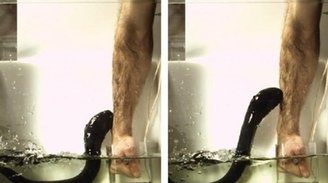播音/撰文 安妮·斯尼德(Annie Sneed)
翻译 许楠
审校 潘磊
Submerged electric eels lose current to water, so they apparently leap into the air to minimize their contact with water and maximize their shock value.
水下的电鳗会流失电流,所以它们会时不时跃入空中以最大限度地减少与水的接触,从而增加它们的电击力。
In the 1800s, renowned explorer and naturalist Alexander von Humboldt observed a bizarre incident in the Amazon: he saw electric eels leaping into the air and shocking two horses. But some who heard the story thought Humboldt was a humbug: “Humboldt had described eels attacking horses…but people didn’t necessarily believe it.”
十九世纪,著名探险家、博物学家亚历山大·亨伯特(Alexander von Humboldt)观察到亚马逊河上非比寻常的一幕:他看见电鳗跃入空中并且袭击了两匹马。但有人却认为亨伯特在唬人:“亨伯特说鳗鱼袭击了马……不过我们不必相信他。”
But Humbolt was vindicated last year, when Catania published a study showing that electric eels indeed jump in the air to jolt potential predators. This maneuver is the most efficient way for an eel to deliver its shock. When the animal is submerged, electricity is lost to the water. By going airborne “the eel is essentially using that principle of physics to divert more and more current into the target.”
但亨伯特的故事却在去年得到了辩护。范德比尔特大学(Vanderbilt University)生物学教授肯尼思•卡塔尼亚进行了一项研究,证明了电鳗的确会跃入空中震慑可能对之有威胁的动物。这一跃是电鳗传导电流最有效的方式。电鳗在水下的时候,电流会在水中流失。“通过空气传导,电鳗实际上是运用了物理规律来向目标者传导尽可能多的电流。”
But Catania still wanted to know more—like, exactly how strong is an eel’s shock to a human? To figure out the forces behind this electrifying leap, Catania used a relatively small eel and a human subject—himself.
卡塔尼亚仍想了解更多——比如,电鳗对人体的攻击能力可以有多强?为了搞清楚这爆发式一跃的威力,卡塔尼亚用了一只小电鳗,以及一个人类受试者——他自己。
“I approached the eel with my hand in a container, which has a metal strip on it. And the eel decided it was concerned about whatever apparent creature might be coming near it…it came out of the water as I planned, up over the metal piece and onto my arm…that allowed me to measure the current flowing through my hand.”
“我用一只手接近容器中的电鳗。这个容器上另外装有一个金属簧片。然后电鳗认为它应该警觉任何一个正在接近它的生物……如我所料,它跃出了水面,飞到了金属片上并且也在我的胳膊上……这让我直接测得了通过我手上的电流。”
After taking various measurements and getting electrocuted 10 times by the eel, Catania discovered that even a small eel can deliver as much as 40 to 50 milliamps of electrical current. That’s more than enough to activate the pain receptors and withdrawal reflexes of horses, dogs and humans.
在经过多次测试,也被鳗鱼电了十多次后,卡塔尼亚发现,即使是一只小电鳗,也可以释放40~50毫安之多的电流。这足以激活马、犬和人类的痛觉感受器并引起屈肌缩回反射。
“So I worked around horses when I was younger, and I backed into an electric fence a couple times. It’s a good analogy for what the eel is doing…and the animals learn not to touch the fence, and the eel teaches you not to touch the eel.”
“我年轻时曾在马场做过一些工作,那时我好几次退到一个通电铁丝网后面。这是一个对鳗鱼的行为很好地类比……那些马学会了不要触碰电网,正如电鳗教我们不要动它们一样。”
Catania’s new research is in the journal Current Biology. No pun intended. [Kenneth C. Catania, Power Transfer to a Human during an Electric Eel’s Shocking Leap]
“It’s a really interesting behavior to be able to quantify, basically, what’s going on when the eel does this, because it’s a unique defense in the animal kingdom.” Plus, “This would basically give you a starting point to figure out what would go on with large electric eels in the Amazon.” Which, as Humboldt showed, are not horsing around.
—Annie Sneed
卡塔尼亚的新研究发表于当代生物学杂志。此处无双关。[Kenneth C. Catania, Power Transfer to a Human during an Electric Eel’s Shocking Leap]
“这是一个很有意思的行为,可以用来量化鳗鱼这样做的时候实质上到底发生了什么,因为这是动物王国中一种独特的自卫方式。”另外,“它可以给你一个切入点去研究亚马逊雨林中有这些大电鳗会发生什么。”毕竟,如亨伯特所说,电鳗周围不是只有马。
——安妮·斯尼德

 京公网安备11010502039775号
京公网安备11010502039775号  京公网安备11010502039775号
京公网安备11010502039775号 
















